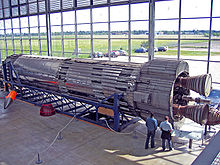This article needs additional citations for verification. (February 2019) |
 Blue Streak at the Deutsches Museum, Schleissheim, Munich | |
| Function | Nuclear strike, satellite vehicle |
|---|---|
| Manufacturer | de Havilland Propellers, Hawker Siddeley Dynamics , Raytheon,[1] Hallicrafters (maintenance and technical support)[2] |
| Country of origin | UK |
| Size | |
| Height | 80 feet (24 m)[3] |
| Capacity | |
| Payload to LEO | |
| Launch history | |
| Status | Retired since 1971 |
| Launch sites | |
| First flight | 5 June 1964 |
| Last flight | 5 November 1971 |
| stage | |
| Powered by | Rolls-Royce RZ.2 |
| Propellant | liquid oxygen/kerosene |
The de Havilland Propellers Blue Streak was a British Intermediate-range ballistic missile (IRBM), and later the first stage of the Europa satellite launch vehicle. Blue Streak was cancelled without entering full production.[4]
The project was intended to maintain an independent British nuclear deterrent, replacing the V bomber fleet which would become obsolete by 1965. The operational requirement for the missile was issued in 1955 and the design was complete by 1957. During development, it became clear that the missile system was too expensive and too vulnerable to a surprise attack. The missile project was cancelled in 1960, with US-led Skybolt the preferred replacement.
Partly to avoid political embarrassment from the cancellation,[according to whom?] the UK government proposed that the rocket be used as the first stage of a civilian satellite launcher called Black Prince. As the cost was thought to be too great for the UK alone, international collaboration was sought. This led to the formation of the European Launcher Development Organisation (ELDO), with Blue Streak used as the first stage of a carrier rocket named Europa.[citation needed]
Europa was tested at Woomera Test Range, Australia and later at Kourou in French Guiana. Following launch failures, the ELDO project was cancelled in 1972 and Blue Streak with it.[citation needed]
- ^ Missiles and Rockets, 28 November 1960, p. 59.
- ^ Hallicrafters World Wide “Btue Streak” Project. // Aviation Week & Space Technology, Mid-December, 1960, v. 73, no. 27, p. 189.
- ^ Goldring, Mary (26 May 1960). "The cost of Blue Streak as a satellite launcher". New Scientist. 7 (184): 1332.
- ^ List, Jenny (7 February 2019). "Oops… Britain Launched A Satellite, But Who Remembers It?". Hackaday. Retrieved 9 February 2019.